【ESP32S3接入讯飞在线语音识别】
视频地址:
【ESP32S3接入讯飞在线语音识别】
1. 前言
使用Seeed XIAO ESP32S3 Sense开发板接入讯飞实现在线语音识别。自带麦克风模块用做语音输入,通过串口发送字符“1”来控制数据的采集和上传。

语音识别对比
| 平台 | api | 教程 | 评分 |
|---|---|---|---|
| 百度 | https://ai.baidu.com/tech/speech | 【ESP32S3 Sense接入百度在线语音识别】 | 7分 |
| 讯飞 | https://console.xfyun.cn/services/iat | 【ESP32S3接入讯飞在线语音识别】 | 8分 |
1.1 步骤概括
(1) 在讯飞控制端选择“语音识别”并创建应用获取API Key和Secret Key获取token
(2)采集音频数据,将数据打包成规定的格式,POST发送到请求API
(3) 接收返回的识别数据

1.2 硬件介绍
要学习本教程,您需要1个 ESP32S3 开发板。
目前这是我使用的ESP32S3官方硬件👍👍👍(小小的身材有大大的力量)只需要35元加摄像头麦克风79元,后期我会整理相关专栏进行Arduino系统学习😘😘😘。有需要可以购买xiao开发板💕💕💕
-
SeeedXIAO ESP32S3 Sense硬件购买地址:https://s.click.taobao.com/lekazrt
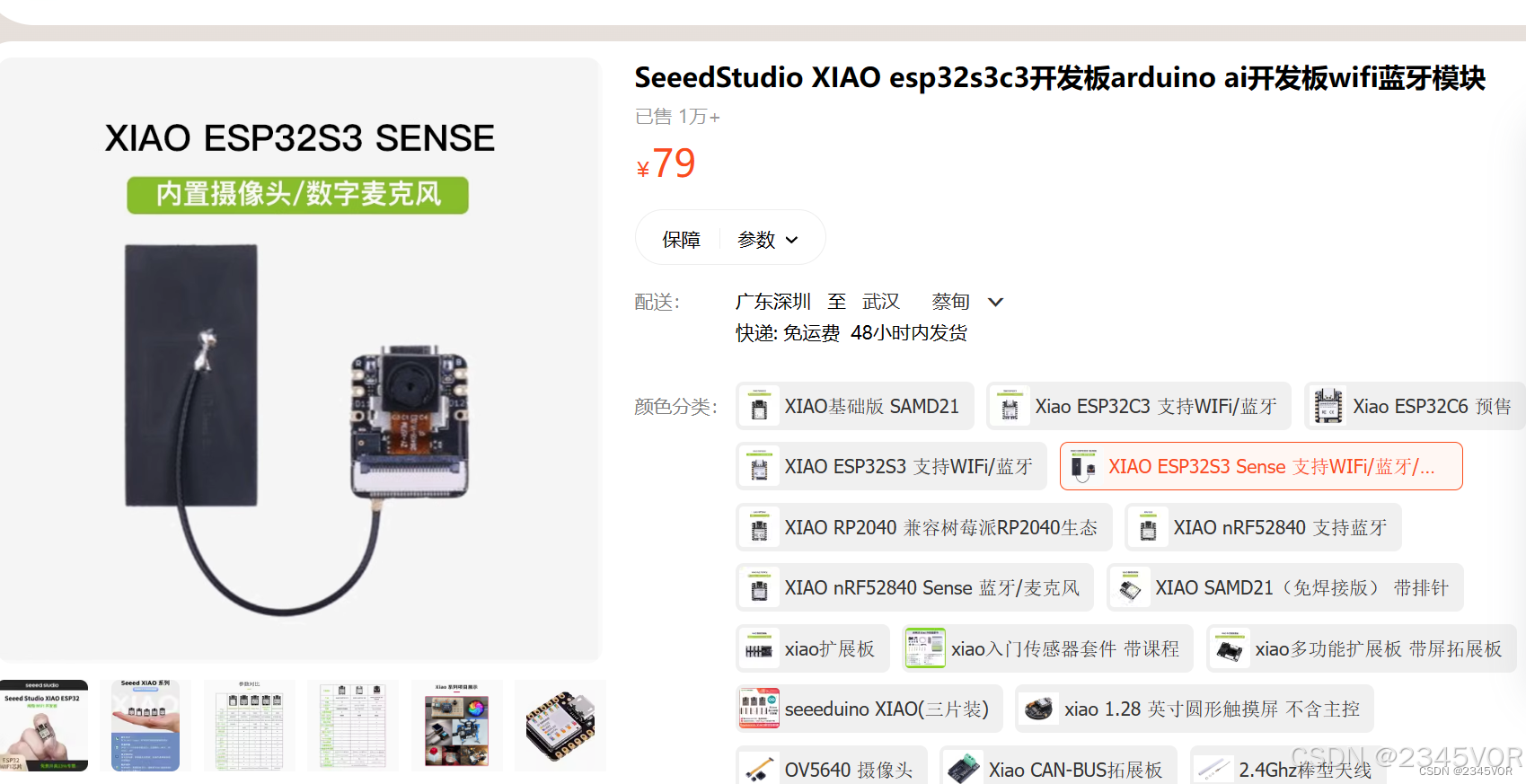
-
ESP32-S3-CAM 核心开发板 N16R8 wifi蓝牙模块 OV2640摄像头硬件购买地址:https://s.click.taobao.com/1PTagos

上面两者esp32s3仍选其一,还需要麦克风INMP441全向麦克风模块 MEMS 高精度 低功耗 I2S接口 支持ESP32
【下单链接】:https://s.click.taobao.com/sNGL3as
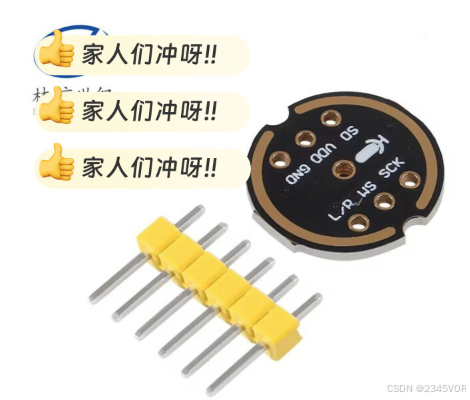
1.3 接线
参考下面接线
| INMP441 | ESP32S3 |
|---|---|
| I2S_WS | GPIO17 |
| I2S_SD | GPIO3 |
| I2S_SCK | GPIO18 |
| VCC | 5V |
| GND | GND |
实物图
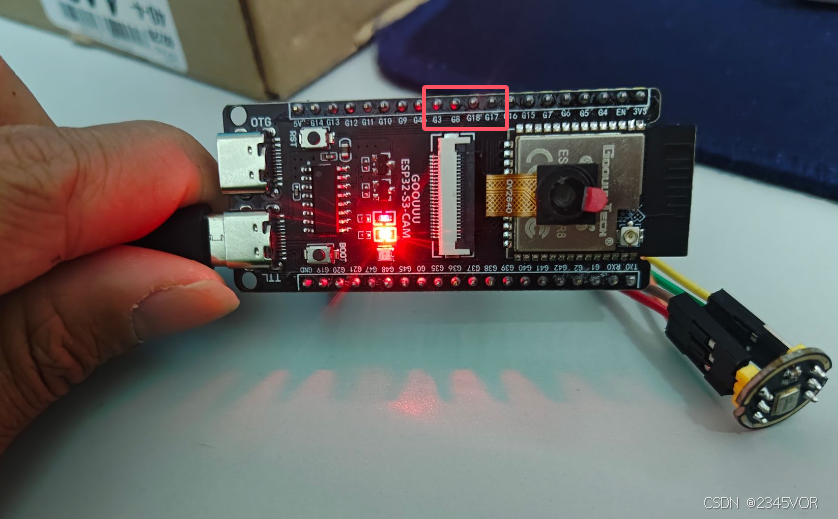
2. 操作流程
2.1 创建语音识别应用
登录讯飞账号,进入控制台,选择语音识别
官网地址:https://www.xfyun.cn/
新用户可以直接领取资源,也可付费接入,创建应用,完善相关内容提交。
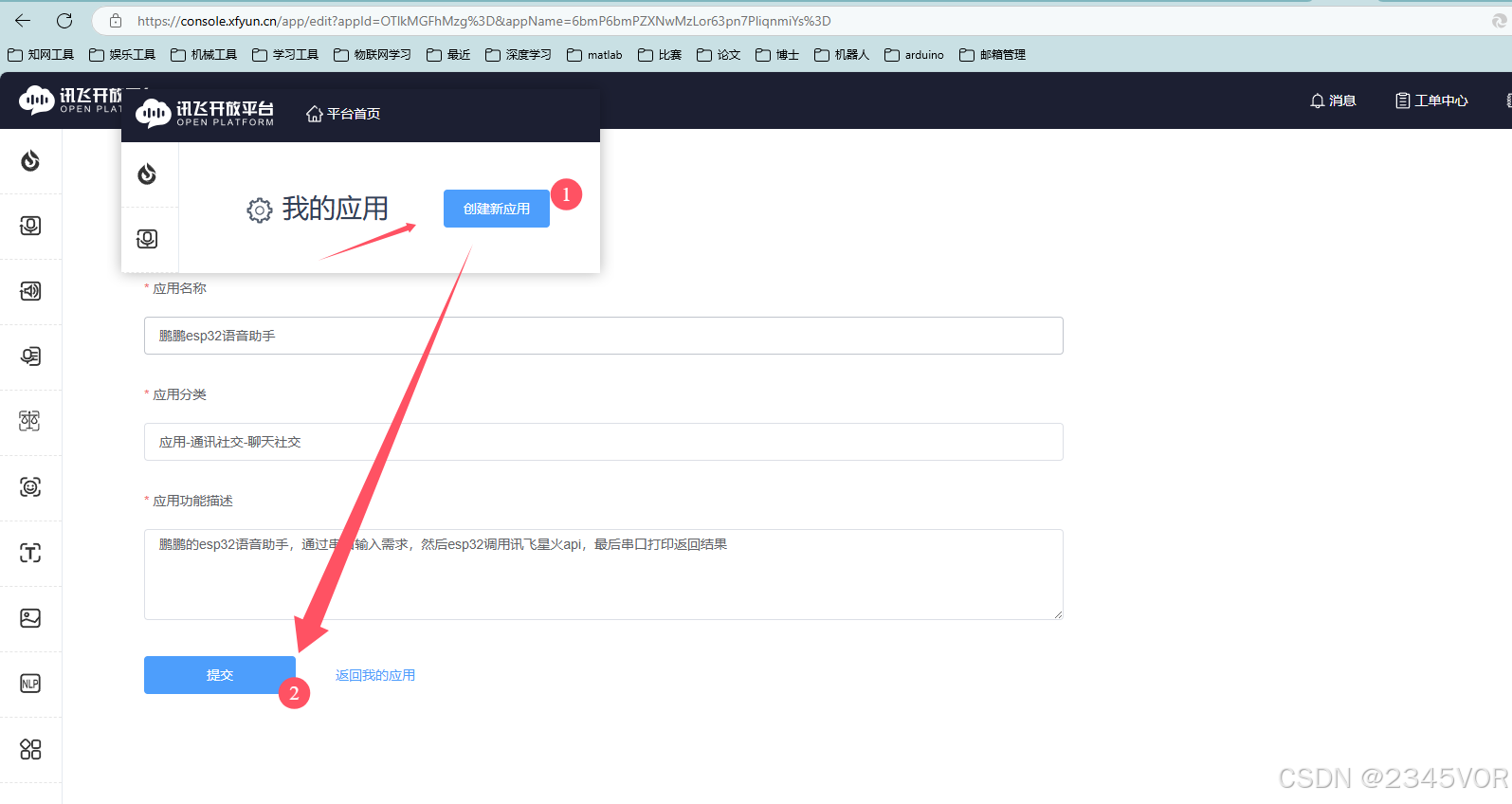
选择语音识别,大家根据自己的情况领取资源或者开通付费使用:https://console.xfyun.cn/services/iat
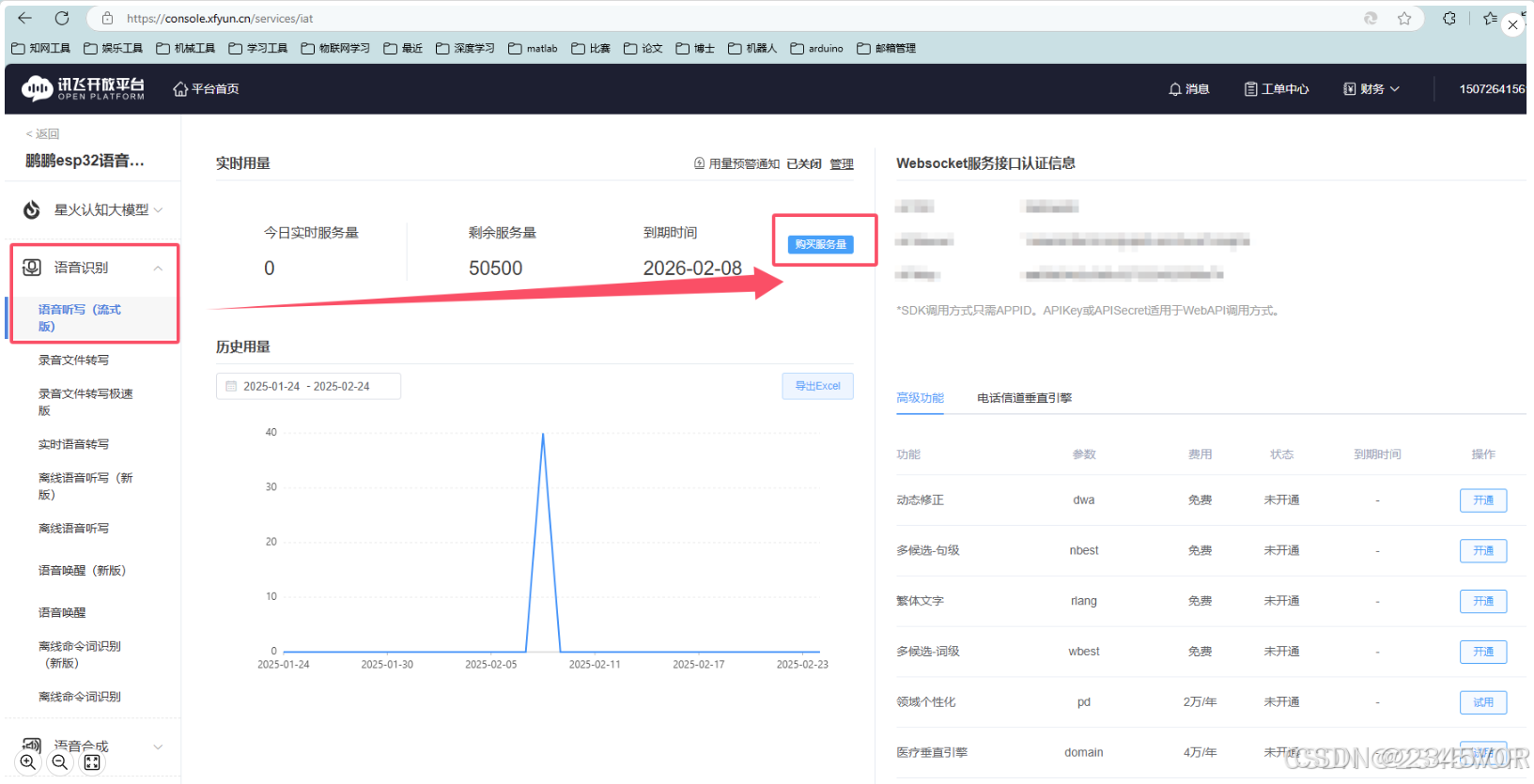
新手领取语音资源,注意有一年时效哦🤣🤣🤣:https://www.xfyun.cn/services/voicedictation?target=price

2.2 记录API秘钥
记录自己的接口信息
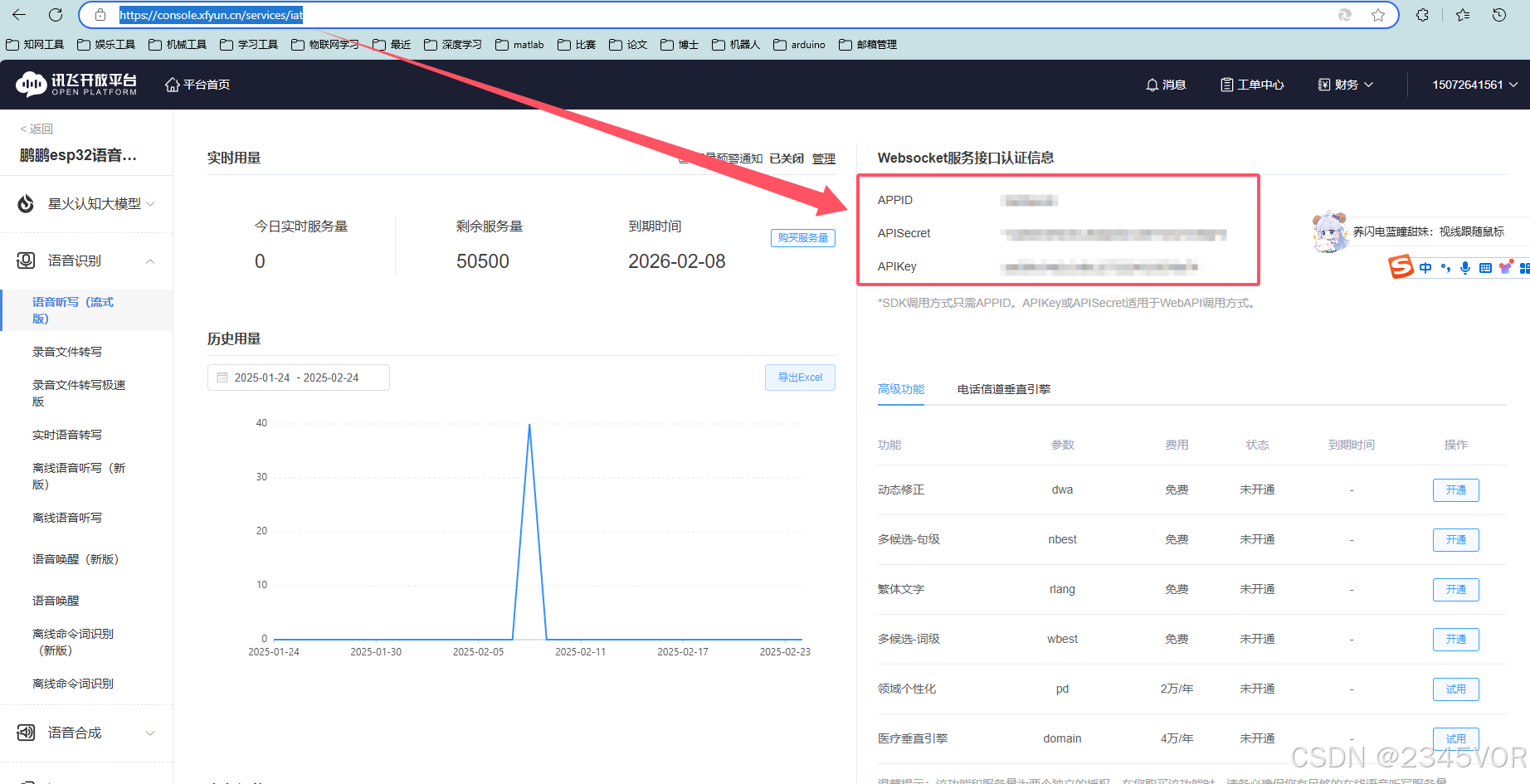
三个参数:
// 讯飞STT 的key
String STTAPPID = "99d038";
const char *STTAPISecret = "YzMxNGRkODJlNjVjMDUZTc5MjFh";
const char *STTAPIKey = "aa09fe34b2c3d8c327222463f8e74";
3. JSON语音接入api
语音听写(流式版)WebAPI 文档:https://www.xfyun.cn/doc/asr/voicedictation/API.html
语音听写流式接口,用于1分钟内的即时语音转文字技术,支持实时返回识别结果,达到一边上传音频一边获得识别文本的效果。
3.1 JSON格式
接口要求:

3.2 交互流程
接口数据传输与接收,握手成功后客户端和服务端会建立Websocket连接,客户端通过Websocket连接可以同时上传和接收数据。当服务端有识别结果时,会通过Websocket连接推送识别结果到客户端。发送数据时,如果间隔时间太短,可能会导致引擎识别有误。
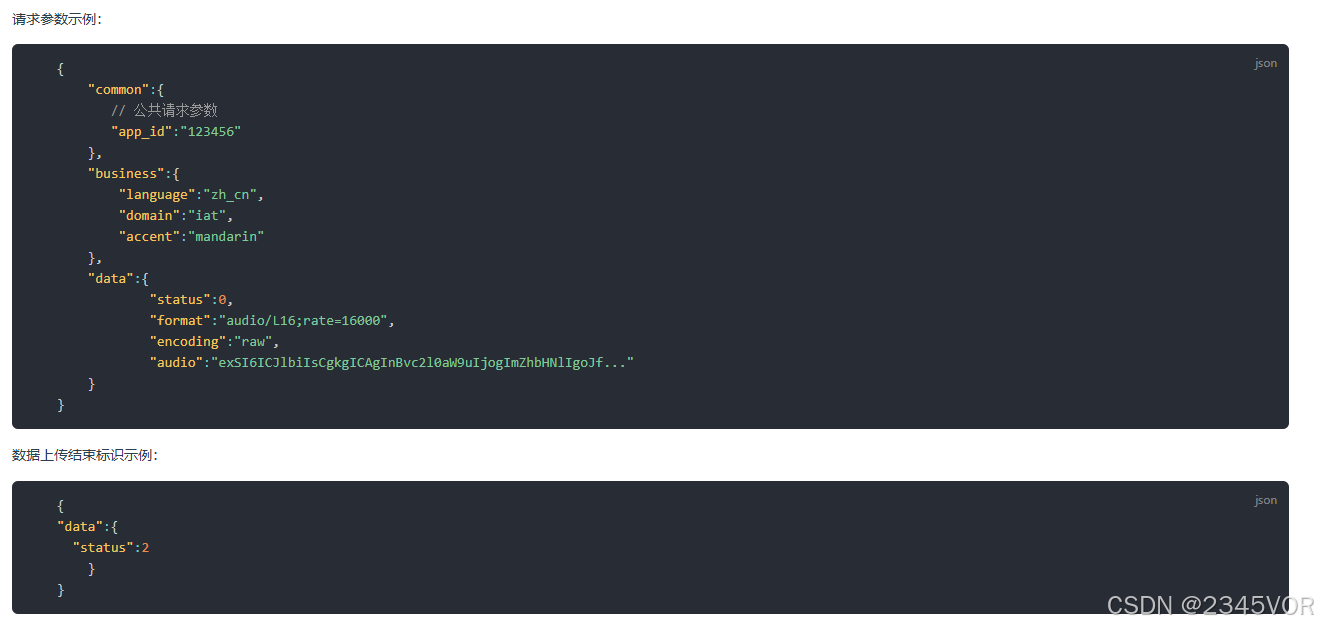
3.2 ESP32S3 Sense接入代码
这里采用Platfromio框架接入,arduino IED也是可以的
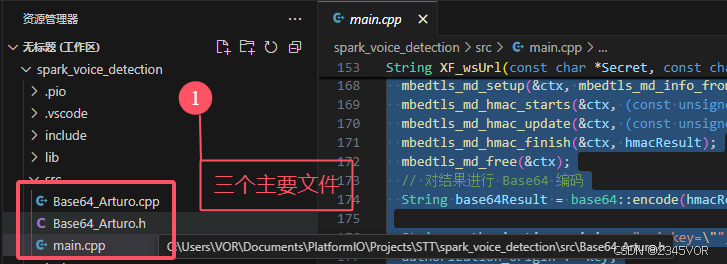
图中对数据类型和内容说的很明确了,只需要按照这个格式打包好数据然后发送就行,下面是ESP32S3的具体实现代码。
main.cpp
// 代码参考:https://oshwhub.com/shukkkk/esp32s3_tft_mp3
#include <Arduino.h>
#include <Adafruit_NeoPixel.h>
#include <WiFi.h>
#include "time.h"
#include "esp_sntp.h"
#include <mbedtls/md.h>
#include <base64.h>
#include "Base64_Arturo.h"
#include <ArduinoWebsockets.h>
#include <ArduinoJson.h>
#include <driver/i2s.h>
#include "SPI.h"
#include <HTTPClient.h>
#include <NTPClient.h>
#include <WiFiUdp.h>
#include <esp_system.h>
#define PIN_PIXS 48
#define PIX_NUM 1
Adafruit_NeoPixel pixels(PIX_NUM, PIN_PIXS, NEO_GRB + NEO_KHZ800);
#define I2S_WS 17
#define I2S_SD 3
#define I2S_SCK 18
#define I2S_PORT_0 I2S_NUM_0
#define SAMPLE_RATE 16000
#define RECORD_TIME_SECONDS 10
#define BUFFER_SIZE (SAMPLE_RATE * RECORD_TIME_SECONDS)
#define CHUNK_SIZE 2048
const int recordTimeSeconds = 3;//录音时间秒为单位
int16_t audioData[2560];
int16_t *pcm_data; // 录音缓存区
uint recordingSize = 0;
// char* psramBuffer = (char*)ps_malloc(512000);
String odl_answer;
String answer_list[10];
uint8_t answer_list_num = 0;
bool answer_ste = 0;
const char *ssid = "IQOO";
const char *password = "12345678";
// 讯飞STT 的key
String STTAPPID = "99d038";
const char *STTAPISecret = "YzMxNGRkODJlNjVjMDUZTc5MjFh";
const char *STTAPIKey = "aa09fe34b2c3d8c327222463f8e74";
using namespace websockets;
WebsocketsClient client;
const char *ntpServer1 = "ntp.org";
const char *ntpServer2 = "ntp.ntsc.ac.cn";
const long gmtOffset_sec = 3600;
const int daylightOffset_sec = 3600;
WiFiUDP ntpUDP;
NTPClient timeClient(ntpUDP, "pool.ntp.org");
void setup_ntp_client()
{
timeClient.begin();
// 设置时区
// GMT +1 = 3600
// GMT +8 = 28800
// GMT -1 = -3600
// GMT 0 = 0
timeClient.setTimeOffset(+28800);
}
bool timeste = 0;
String stttext = "";
bool sttste = 0;
String unixTimeToGMTString(time_t unixTime)
{
char buffer[80];
struct tm timeinfo;
gmtime_r(&unixTime, &timeinfo);
strftime(buffer, sizeof(buffer), "%a, %d %b %Y %H:%M:%S GMT", &timeinfo);
return String(buffer);
}
String getDateTime()
{
// 请求网络时间
timeClient.update();
unsigned long epochTime = timeClient.getEpochTime();
Serial.print("Epoch Time: ");
Serial.println(epochTime);
String timeString = unixTimeToGMTString(epochTime);
// 打印结果
Serial.println(timeString);
return timeString;
}
void i2s_install()
{
const i2s_config_t i2s_config = {
.mode = (i2s_mode_t)(I2S_MODE_MASTER | I2S_MODE_RX),
.sample_rate = SAMPLE_RATE,
.bits_per_sample = i2s_bits_per_sample_t(16),
.channel_format = I2S_CHANNEL_FMT_ONLY_LEFT,
.communication_format = i2s_comm_format_t(I2S_COMM_FORMAT_STAND_I2S),
.intr_alloc_flags = 0, // default interrupt priority
.dma_buf_count = 8,
.dma_buf_len = 1024,
.use_apll = false};
esp_err_t err = i2s_driver_install(I2S_PORT_0, &i2s_config, 0, NULL);
if (err != ESP_OK)
{
Serial.printf("I2S driver install failed (I2S_PORT_0): %d\n", err);
while (true)
;
}
}
void i2s_setpin()
{
const i2s_pin_config_t pin_config = {
.bck_io_num = I2S_SCK,
.ws_io_num = I2S_WS,
.data_out_num = I2S_PIN_NO_CHANGE,
.data_in_num = I2S_SD};
esp_err_t err = i2s_set_pin(I2S_PORT_0, &pin_config);
if (err != ESP_OK)
{
Serial.printf("I2S set pin failed (I2S_PORT_0): %d\n", err);
while (true)
;
}
}
// 处理url格式
String formatDateForURL(String dateString)
{
// 替换空格为 "+"
dateString.replace(" ", "+");
dateString.replace(",", "%2C");
dateString.replace(":", "%3A");
return dateString;
}
// 构造讯飞ws连接url
String XF_wsUrl(const char *Secret, const char *Key, String request, String host)
{
String timeString = getDateTime();
String signature_origin = "host: " + host;
signature_origin += "\n";
signature_origin += "date: ";
signature_origin += timeString;
signature_origin += "\n";
signature_origin += "GET " + request + " HTTP/1.1";
// 使用 mbedtls 计算 HMAC-SHA256
unsigned char hmacResult[32]; // SHA256 产生的哈希结果长度为 32 字节
mbedtls_md_context_t ctx;
mbedtls_md_type_t md_type = MBEDTLS_MD_SHA256;
mbedtls_md_init(&ctx);
mbedtls_md_setup(&ctx, mbedtls_md_info_from_type(md_type), 1); // 1 表示 HMAC
mbedtls_md_hmac_starts(&ctx, (const unsigned char *)Secret, strlen(Secret));
mbedtls_md_hmac_update(&ctx, (const unsigned char *)signature_origin.c_str(), signature_origin.length());
mbedtls_md_hmac_finish(&ctx, hmacResult);
mbedtls_md_free(&ctx);
// 对结果进行 Base64 编码
String base64Result = base64::encode(hmacResult, 32);
String authorization_origin = "api_key=\"";
authorization_origin += Key;
authorization_origin += "\", algorithm=\"hmac-sha256\", headers=\"host date request-line\", signature=\"";
authorization_origin += base64Result;
authorization_origin += "\"";
String authorization = base64::encode(authorization_origin);
String url = "ws://" + host + request;
url += "?authorization=";
url += authorization;
url += "&date=";
url += formatDateForURL(timeString);
url += "&host=" + host;
return url;
}
// 向讯飞STT发送音频数据
void STTsend()
{
uint8_t status = 0;
int dataSize = 1280 * 8;
int audioDataSize = recordingSize * 2;
uint lan = (audioDataSize) / dataSize;
uint lan_end = (audioDataSize) % dataSize;
if (lan_end > 0)
{
lan++;
}
// Serial.printf("byteDatasize: %d , lan: %d , lan_end: %d \n", audioDataSize, lan, lan_end);
String host_url = XF_wsUrl(STTAPISecret, STTAPIKey, "/v2/iat", "ws-api.xfyun.cn");
Serial.println("Connecting to server.");
bool connected = client.connect(host_url);
if (connected)
{
Serial.println("Connected!");
}
else
{
Serial.println("Not Connected!");
}
// 分段向STT发送PCM音频数据
for (int i = 0; i < lan; i++)
{
if (i == (lan - 1))
{
status = 2;
}
if (status == 0)
{
String input = "{";
input += "\"common\":{ \"app_id\":\"" + STTAPPID + "\" },";
input += "\"business\":{\"domain\": \"iat\", \"language\": \"zh_cn\", \"accent\": \"mandarin\", \"vinfo\":1,\"vad_eos\":10000},";
input += "\"data\":{\"status\": 0, \"format\": \"audio/L16;rate=16000\",\"encoding\": \"raw\",\"audio\":\"";
String base64audioString = base64::encode((uint8_t *)pcm_data, dataSize);
input += base64audioString;
input += "\"}}";
Serial.printf("input: %d , status: %d \n", i, status);
client.send(input);
status = 1;
}
else if (status == 1)
{
String input = "{";
input += "\"data\":{\"status\": 1, \"format\": \"audio/L16;rate=16000\",\"encoding\": \"raw\",\"audio\":\"";
String base64audioString = base64::encode((uint8_t *)pcm_data + (i * dataSize), dataSize);
input += base64audioString;
input += "\"}}";
// Serial.printf("input: %d , status: %d \n", i, status);
client.send(input);
}
else if (status == 2)
{
if (lan_end == 0)
{
String input = "{";
input += "\"data\":{\"status\": 2, \"format\": \"audio/L16;rate=16000\",\"encoding\": \"raw\",\"audio\":\"";
String base64audioString = base64::encode((uint8_t *)pcm_data + (i * dataSize), dataSize);
input += base64audioString;
input += "\"}}";
Serial.printf("input: %d , status: %d \n", i, status);
client.send(input);
}
if (lan_end > 0)
{
String input = "{";
input += "\"data\":{\"status\": 2, \"format\": \"audio/L16;rate=16000\",\"encoding\": \"raw\",\"audio\":\"";
String base64audioString = base64::encode((uint8_t *)pcm_data + (i * dataSize), lan_end);
input += base64audioString;
input += "\"}}";
Serial.printf("input: %d , status: %d \n", i, status);
client.send(input);
}
}
delay(30);
}
}
void setup()
{
Serial.begin(115200);
pinMode(48, OUTPUT);
digitalWrite(48, HIGH);
Serial.printf("Connecting to %s ", ssid);
WiFi.begin(ssid, password);
while (WiFi.status() != WL_CONNECTED)
{
delay(500);
Serial.print(".");
}
Serial.println(" CONNECTED");
setup_ntp_client();
getDateTime();
pixels.begin();
pixels.setBrightness(8);
// 熄灭2812
pixels.clear();
pixels.show();
Serial.println("Setup I2S ...");
i2s_install();
i2s_setpin();
esp_err_t err = i2s_start(I2S_PORT_0);
if (err != ESP_OK)
{
Serial.printf("I2S start failed (I2S_PORT_0): %d\n", err);
while (true)
;
}
// run callback when messages are received
client.onMessage([&](WebsocketsMessage message) {
// STT ws连接的回调函数
Serial.print("Got Message: ");
Serial.println(message.data());
JsonDocument doc;
DeserializationError error = deserializeJson(doc, message.data());
if (error)
{
Serial.print(F("deserializeJson() failed: "));
Serial.println(error.f_str());
return;
}
JsonArray ws = doc["data"]["result"]["ws"];
for (JsonObject word : ws)
{
int bg = word["bg"];
const char *w = word["cw"][0]["w"];
stttext += w;
}
if (doc["data"]["status"] == 2)
{
// 收到结束标志
sttste = 1;
Serial.print("语音识别:");
Serial.println(stttext);
}
});
}
void loop()
{
if (Serial.available())
{
// delay(20);
if (Serial.read() == '1')
{
stttext = "";
Serial.println("Recording...");
size_t bytes_read = 0;
recordingSize = 0;
// 分配 pcm_data
pcm_data = (int16_t *)ps_malloc(BUFFER_SIZE * sizeof(int16_t));
if (!pcm_data)
{
Serial.println("Failed to allocate memory for pcm_data from PSRAM");
return;
}
// uint16_t x = 0, y = 0;
while (recordingSize < recordTimeSeconds* SAMPLE_RATE)
{
// 开始循环录音,将录制结果保存在pcm_data中
esp_err_t result = i2s_read(I2S_PORT_0, audioData, sizeof(audioData), &bytes_read, portMAX_DELAY);
memcpy(pcm_data + recordingSize, audioData, bytes_read);
recordingSize += bytes_read / 2;
}
Serial.printf("Total bytes read: %d\n", recordingSize);
Serial.println("Recording complete.");
STTsend(); // STT请求开始
free(pcm_data);
}
}
if (client.available())
{
client.poll();
}
delay(50);
}
需要自己替换wifi和api参数
const char *ssid = "IQOO";
const char *password = "12345678";
// 讯飞STT 的key
String STTAPPID = "99d038";
const char *STTAPISecret = "YzMxNGRkODJlNjVjMDUZTc5MjFh";
const char *STTAPIKey = "aa09fe34b2c3d8c327222463f8e74";
Base64_Arturo.cpp
/*
Copyright (C) 2016 Arturo Guadalupi. All right reserved.
This library is free software; you can redistribute it and/or modify it under the terms of the GNU Lesser General Public License as published by the Free Software Foundation; either version 2.1 of the License, or (at your option) any later version.
This library is distributed in the hope that it will be useful, but WITHOUT ANY WARRANTY; without even the implied warranty of MERCHANTABILITY or FITNESS FOR A PARTICULAR PURPOSE. See the GNU Lesser General Public License for more details.
*/
#include "Base64_Arturo.h"
#include <Arduino.h>
#if (defined(__AVR__))
#include <avr/pgmspace.h>
#else
#include <pgmspace.h>
#endif
const char PROGMEM _Base64AlphabetTable[] = "ABCDEFGHIJKLMNOPQRSTUVWXYZ"
"abcdefghijklmnopqrstuvwxyz"
"0123456789+/";
int Base64Class::encode(char *output, char *input, int inputLength) {
int i = 0, j = 0;
int encodedLength = 0;
unsigned char A3[3];
unsigned char A4[4];
while(inputLength--) {
A3[i++] = *(input++);
if(i == 3) {
fromA3ToA4(A4, A3);
for(i = 0; i < 4; i++) {
output[encodedLength++] = pgm_read_byte(&_Base64AlphabetTable[A4[i]]);
}
i = 0;
}
}
if(i) {
for(j = i; j < 3; j++) {
A3[j] = '\0';
}
fromA3ToA4(A4, A3);
for(j = 0; j < i + 1; j++) {
output[encodedLength++] = pgm_read_byte(&_Base64AlphabetTable[A4[j]]);
}
while((i++ < 3)) {
output[encodedLength++] = '=';
}
}
output[encodedLength] = '\0';
return encodedLength;
}
int Base64Class::decode(char * output, char * input, int inputLength) {
int i = 0, j = 0;
int decodedLength = 0;
unsigned char A3[3];
unsigned char A4[4];
while (inputLength--) {
if(*input == '=') {
break;
}
A4[i++] = *(input++);
if (i == 4) {
for (i = 0; i <4; i++) {
A4[i] = lookupTable(A4[i]);
}
fromA4ToA3(A3,A4);
for (i = 0; i < 3; i++) {
output[decodedLength++] = A3[i];
}
i = 0;
}
}
if (i) {
for (j = i; j < 4; j++) {
A4[j] = '\0';
}
for (j = 0; j <4; j++) {
A4[j] = lookupTable(A4[j]);
}
fromA4ToA3(A3,A4);
for (j = 0; j < i - 1; j++) {
output[decodedLength++] = A3[j];
}
}
output[decodedLength] = '\0';
return decodedLength;
}
int Base64Class::encodedLength(int plainLength) {
int n = plainLength;
return (n + 2 - ((n + 2) % 3)) / 3 * 4;
}
int Base64Class::decodedLength(char * input, int inputLength) {
int i = 0;
int numEq = 0;
for(i = inputLength - 1; input[i] == '='; i--) {
numEq++;
}
long long result = ((6LL * inputLength) / 8) - numEq;
//return ((6 * inputLength) / 8) - numEq;
return static_cast<int>(result);
}
//Private utility functions
inline void Base64Class::fromA3ToA4(unsigned char * A4, unsigned char * A3) {
A4[0] = (A3[0] & 0xfc) >> 2;
A4[1] = ((A3[0] & 0x03) << 4) + ((A3[1] & 0xf0) >> 4);
A4[2] = ((A3[1] & 0x0f) << 2) + ((A3[2] & 0xc0) >> 6);
A4[3] = (A3[2] & 0x3f);
}
inline void Base64Class::fromA4ToA3(unsigned char * A3, unsigned char * A4) {
A3[0] = (A4[0] << 2) + ((A4[1] & 0x30) >> 4);
A3[1] = ((A4[1] & 0xf) << 4) + ((A4[2] & 0x3c) >> 2);
A3[2] = ((A4[2] & 0x3) << 6) + A4[3];
}
inline unsigned char Base64Class::lookupTable(char c) {
if(c >='A' && c <='Z') return c - 'A';
if(c >='a' && c <='z') return c - 71;
if(c >='0' && c <='9') return c + 4;
if(c == '+') return 62;
if(c == '/') return 63;
return -1;
}
Base64Class Base64_Arturo;
Base64_Arturo.h
/*
Copyright (C) 2016 Arturo Guadalupi. All right reserved.
This library is free software; you can redistribute it and/or modify it under the terms of the GNU Lesser General Public License as published by the Free Software Foundation; either version 2.1 of the License, or (at your option) any later version.
This library is distributed in the hope that it will be useful, but WITHOUT ANY WARRANTY; without even the implied warranty of MERCHANTABILITY or FITNESS FOR A PARTICULAR PURPOSE. See the GNU Lesser General Public License for more details.
*/
#ifndef _BASE64_H
#define _BASE64_H
class Base64Class{
public:
int encode(char *output, char *input, int inputLength);
int decode(char * output, char * input, int inputLength);
int encodedLength(int plainLength);
int decodedLength(char * input, int inputLength);
private:
inline void fromA3ToA4(unsigned char * A4, unsigned char * A3);
inline void fromA4ToA3(unsigned char * A3, unsigned char * A4);
inline unsigned char lookupTable(char c);
};
extern Base64Class Base64_Arturo;
#endif // _BASE64_H
以下是该代码的简要功能介绍:
1. 核心功能
这是一个基于ESP32-S3的语音识别系统,主要实现:
- 通过麦克风录制音频(I2S接口)
- 连接讯飞开放平台进行语音转文字(STT)
- 网络时间同步(NTP)
- WS2812 LED状态指示
- 串口交互控制
2. 主要模块
硬件配置:
- WS2812 LED(GPIO48)
- I2S麦克风(GPIO17,3,18)
- WiFi网络连接
音频处理:
- 使用I2S接口采集音频数据
- 支持16kHz采样率、16位深PCM格式
- 可录制3秒音频(可调
recordTimeSeconds)语音识别:
- 通过WebSocket连接讯飞语音识别服务
- 支持实时分段传输音频数据
- 采用Base64编码和HMAC-SHA256加密
网络服务:
- WiFi连接(2.4GHz)
- NTP网络时间同步
- HTTPS/WebSocket通信
交互控制:
- 通过串口发送’1’触发录音
- 实时返回识别结果到串口
- LED状态指示(当前未实现具体逻辑)
3. 工作流程
- 上电后连接WiFi和NTP服务器
- 初始化音频采集系统
- 等待串口输入’1’触发录音
- 录制3秒音频存入PSRAM
- 分段发送音频到讯飞云服务
- 接收识别结果并拼接成完整文本
- 通过串口输出识别结果
4. 典型应用场景
- 语音控制智能设备
- 语音备忘录系统
- 实时语音转文字设备
- IoT设备的语音交互接口
5. 关键技术点
- 低延迟音频采集:使用I2S DMA传输
- 大内存管理:采用PSRAM存储音频数据
- 安全通信:HMAC-SHA256签名验证
- 实时协议:WebSocket双向通信
- 语音分段处理:支持多数据包传输
6. 待完善功能
- LED状态指示逻辑
- 错误处理机制
- 本地音频缓存管理
- 离线语音识别支持
该代码实现了从硬件音频采集到云端语音识别的完整链路,可作为语音交互类IoT设备的基础框架。
4. 接收数据
参考以下烧录配置platformio.ini,
; PlatformIO Project Configuration File
;
; Build options: build flags, source filter
; Upload options: custom upload port, speed and extra flags
; Library options: dependencies, extra library storages
; Advanced options: extra scripting
;
; Please visit documentation for the other options and examples
; https://docs.platformio.org/page/projectconf.html
[env:esp32s3-cam]
platform = espressif32
board = esp32-s3-devkitc-1
framework = arduino
board_build.arduino.memory_type = dio_opi
board_upload.flash_size = 16MB
board_build.partitions = default_16MB.csv
board_build.mcu = esp32s3
monitor_speed = 115200
upload_speed = 921600
lib_deps =
bblanchon/ArduinoJson@^7.3.0
arduino-libraries/NTPClient@^3.2.1
gilmaimon/ArduinoWebsockets@^0.5.4
adafruit/Adafruit NeoPixel @ ^1.12.2
build_flags =
-DBOARD_HAS_PSRAM
-mfix-esp32-psram-cache-issue
串口输入字符“1”文本,没有结束符点击按回车键,然后有3s录音时间。等待百度在线语音识别返回,在上一步的代码中实现了接收数据,这里列一下返回的数据。
............................. CONNECTED
23:28:10:629 -> Epoch Time: 1740439690
23:28:10:629 -> Mon, 24 Feb 2025 23:28:10 GMT
23:28:10:631 -> Setup I2S ...
23:29:30:973 ---- 已发送 utf8 编码消息: "1" ----
23:29:31:023 -> Recording...
23:29:33:623 -> Total bytes read: 48640
23:29:33:623 -> Recording complete.
23:29:33:686 -> Epoch Time: 1740439774
23:29:33:686 -> Mon, 24 Feb 2025 23:29:34 GMT
23:29:33:692 -> Connecting to server.
23:29:33:857 -> Connected!
23:29:33:862 -> input: 0 , status: 0
23:29:35:172 -> input: 9 , status: 2
23:29:35:517 -> Got Message: {
"code":0,"message":"success","sid":"iat000decb8@dx1953893f1937024802","data":{
"result":{
"sn":1,"ls":false,"bg":0,"ed":0,"vad":{
"ws":[{
"bg":61,"ed":278,"eg":48.86}]},"ws":[{
"bg":25,"cw":[{
"w":"你好","sc":0}]},{
"bg":73,"cw":[{
"sc":0,"w":"呀"}]},{
"bg":97,"cw":[{
"sc":0,"w":","}]},{
"bg":97,"cw":[{
"sc":0,"w":"我"}]},{
"bg":121,"cw":[{
"sc":0,"w":"是"}]},{
"bg":137,"cw":[{
"w":"鹏","sc":0}]},{
"bg":161,"cw":[{
"w":"鹏","sc":0}]}]},"status":0}}
23:29:35:555 -> Got Message: {
"code":0,"message":"success","sid":"iat000decb8@dx1953893f1937024802","data":{
"result":{
"bg":0,"ed":0,"ws":[{
"cw":[{
"sc":0,"w":"。"}],"bg":188}],"sn":2,"ls":true},"status":2}}
23:29:35:572 -> 语音识别:你好呀,我是鹏鹏。
23:29:51:276 ---- 已发送 utf8 编码消息: "1" ----
23:29:51:319 -> Recording...
23:29:53:843 -> Total bytes read: 48640
23:29:53:843 -> Recording complete.
23:29:53:846 -> Epoch Time: 1740439794
23:29:53:849 -> Mon, 24 Feb 2025 23:29:54 GMT
23:29:53:852 -> Connecting to server.
23:29:54:091 -> Connected!
23:29:54:096 -> input: 0 , status: 0
23:29:55:339 -> input: 9 , status: 2
23:29:55:604 -> Got Message: {
"code":0,"message":"success","sid":"iat000dcbb5@dx195389440c7a140802","data":{
"status":0,"result":{
"sn":1,"ls":false,"bg":0,"ed":0,"vad":{
"ws":[{
"bg":71,"ed":300,"eg":46.19}]},"ws":[{
"bg":25,"cw":[{
"sc":0,"w":"快"}]},{
"bg":45,"cw":[{
"sc":0,"w":"到"}]},{
"bg":65,"cw":[{
"sc":0,"w":"晚上"}]},{
"bg":105,"cw":[{
"sc":0,"w":"12点"}]},{
"bg":169,"cw":[{
"sc":0,"w":"休息"}]},{
"bg":209,"cw":[{
"sc":0,"w":"���"}]}]}}}
23:29:55:640 -> Got Message: {
"code":0,"message":"success","sid":"iat000dcbb5@dx195389440c7a140802","data":{
"result":{
"sn":2,"ls":true,"bg":0,"ed":0,"ws":[{
"bg":220,"cw":[{
"sc":0,"w":"。"}]}]},"status":2}}
23:29:55:656 -> 语音识别:快��晚上12点休息吧。
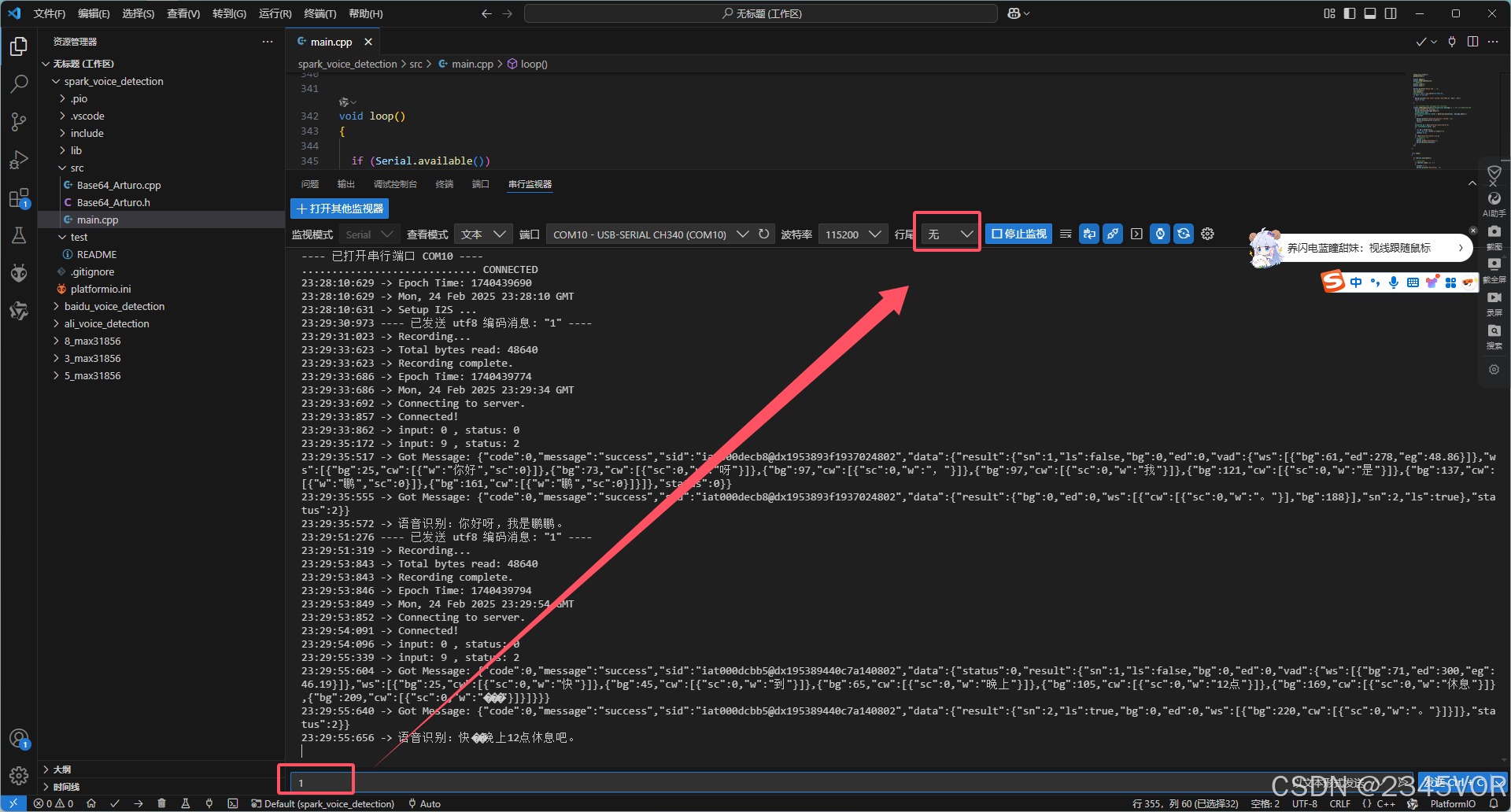
响应速度超级棒2s,数据发送成功则会返回正确的识别数据,当然声音信号不好时返回的语音识别也会不准确。
5. 总结
本文使用ESP32S3开发板接入讯飞实现在线语音识别。自带麦克风模块用做语音输入,通过串口发送字符“1”来控制数据的采集和上传。从而实现对外部世界进行感知,充分认识这个有机与无机的环境,科学地合理地进行创作和发挥效益,然后为人类社会发展贡献一点微薄之力。🤣🤣🤣
- 我会持续更新对应专栏博客,非常期待你的三连!!!🎉🎉🎉
- 如果鹏鹏有哪里说的不妥,还请大佬多多评论指教!!!👍👍👍
- 下面有我的🐧🐧🐧群推广,欢迎志同道合的朋友们加入,期待与你的思维碰撞😘😘😘


























